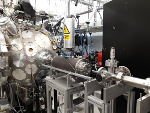| Version 1 (modified by , 7 years ago) ( diff ) |
|---|
"The FOOT (FragmentatiOn Of Target) experiment" - Vincenzo Patera (Roma)
- Abstract
- Slides
- Details:
Date: 27 Feb 2019 Time: 15:00 Venue: Room 539, Blackett Lab Imperial College London Prince Consort Road SW7 2BW
Abstract
Particle therapy uses proton or 12C beams to treat deep-seated solid tumors, and due to the advantageous characteristics of charged particles energy deposition in matter, the maximum of the dose is released to the tumor at the end of the beam range, in the Bragg peak region. However, the beam nuclear interactions with the patient tissues induces fragmentation both of projectile and target nuclei and needs to be carefully taken into account. In proton treatments, the target fragmentation can induce low energy, short range fragments along all the beam path, that may deposit a non negligible dose in the entry channel. On the other hand in 12C treatments the main concern is long range fragments produced by projectile fragmentation that release their dose in the healthy tissues.
The FOOT experiment (FragmentatiOn Of Target) is designed to study these processes. Target ( O and 12C nuclei) fragmentation induced by 150-250 MeV proton beams will be studied via an inverse kinematic approach, where 16O and 12C therapeutic beams collide on graphite and hydrocarbon targets to provide the nuclear fragmentation cross section on hydrogen. Increasing the beam energy to 300-400 MeV/nucleon also the projectile fragmentation of these beams will be explored. Such a detector will also be able to study the interaction of light nuclei (4He, 12C and 16O) with kinetic energy of 800 MeV/nucleon with graphite and hydrocarbon targets, of interest for radioprotection in space. The FOOT collaboration (France, Germany, Japan, Italy) started to design an experimental setup made of an interaction region with beam monitor and start counter, a magnetic spectrometer for the fragments momentum measurement, a thin plastic scintillator for ΔE and time of flight measurements and a BGO calorimeter to measure fragment kinetic energy. The information provided will be combined in order to identify the charge and isotopic number of the fragments. This detector will be paired by a setup where specific emulsion chamber will be coupled to the FOOT interaction region to measure the production in graphite and polyethylene target of light charged fragments as protons, deuterons, tritons and Helium nuclei.
During the seminar the physics program, the detector and the schedule of the experiment will be discussed.
Attachments (1)
- CCAP_Patera_seminar_2019.pdf (87.2 MB ) - added by 7 years ago.
Download all attachments as: .zip
